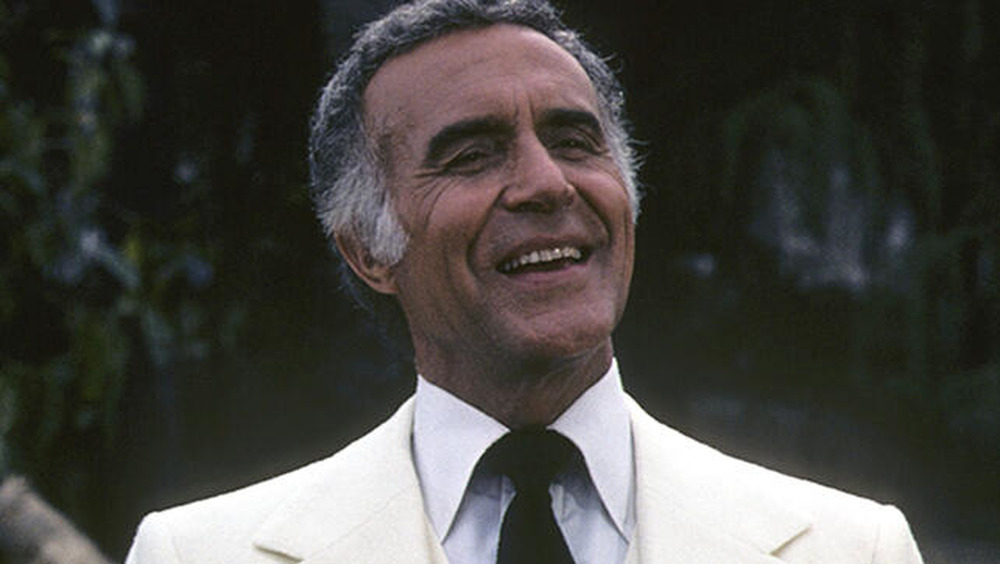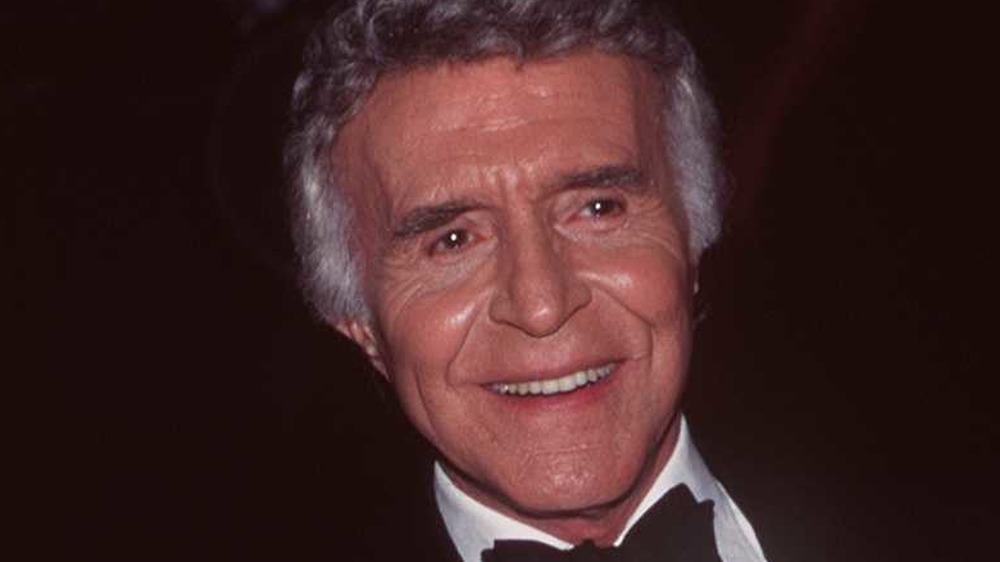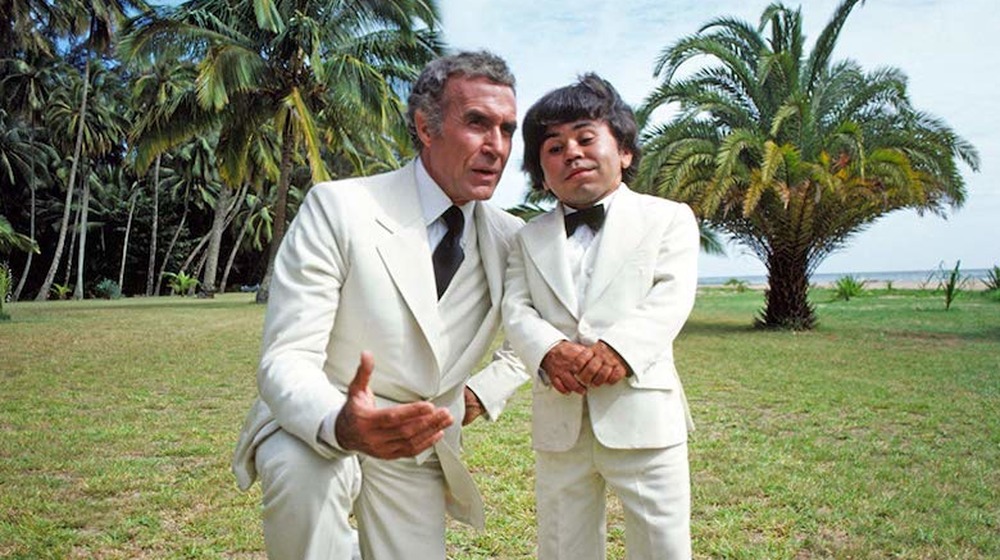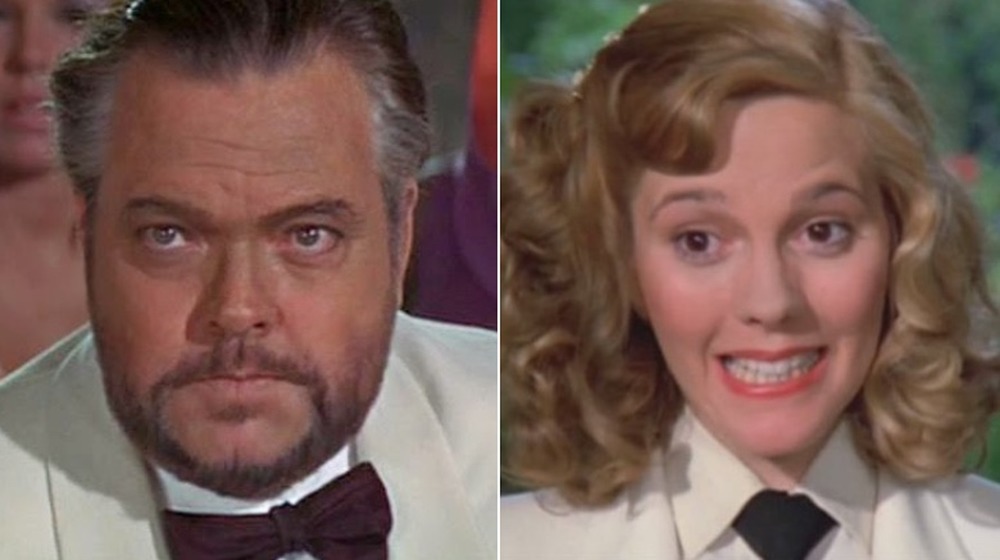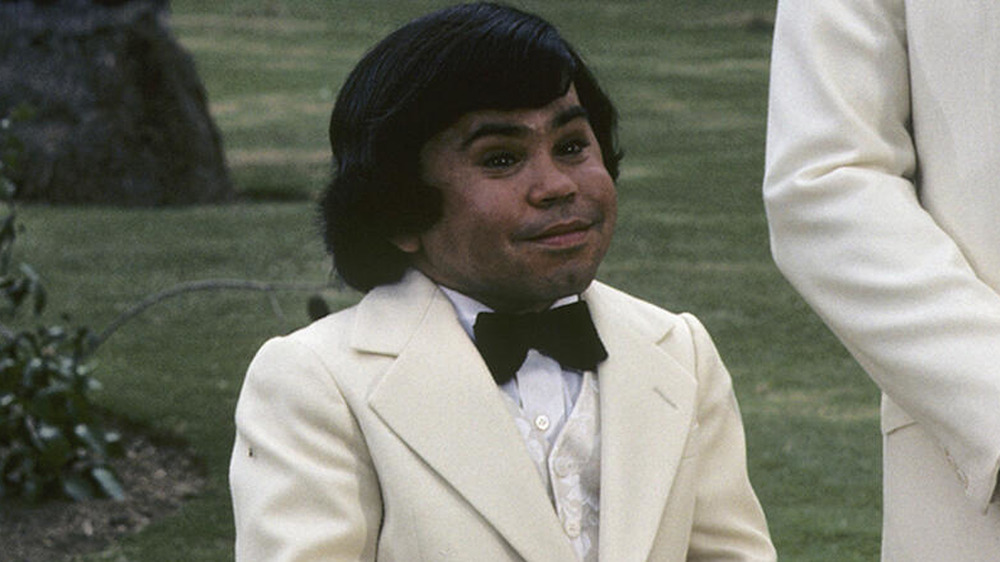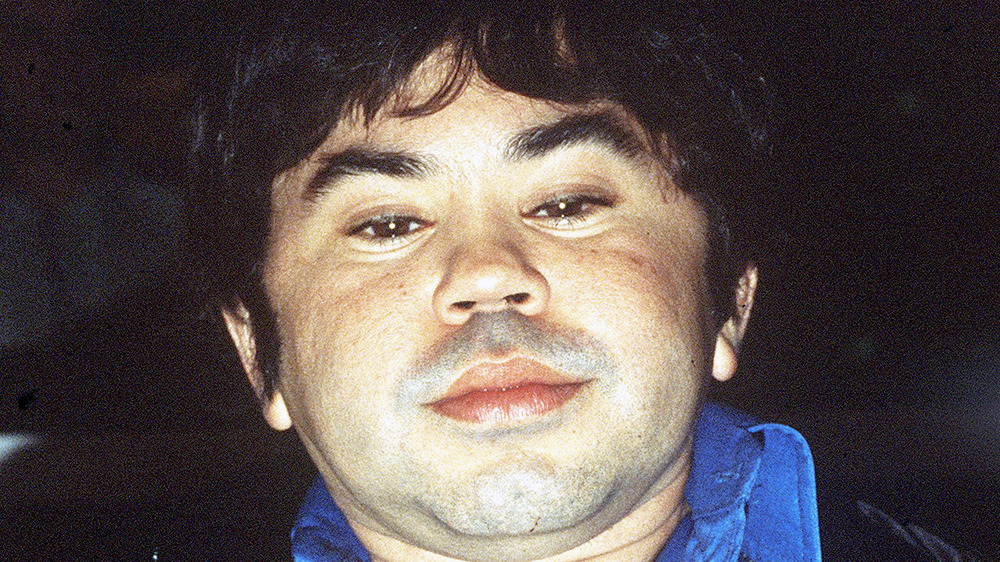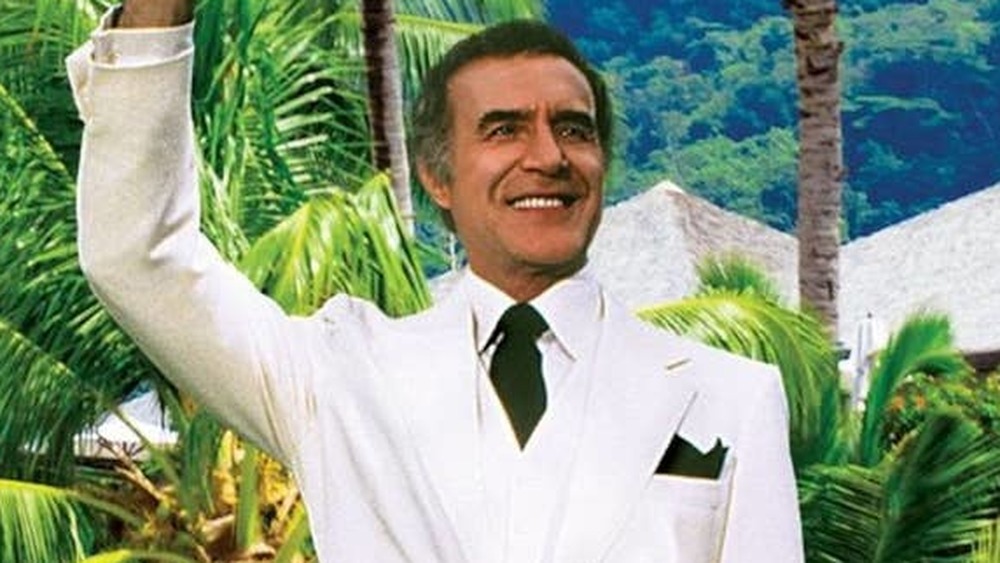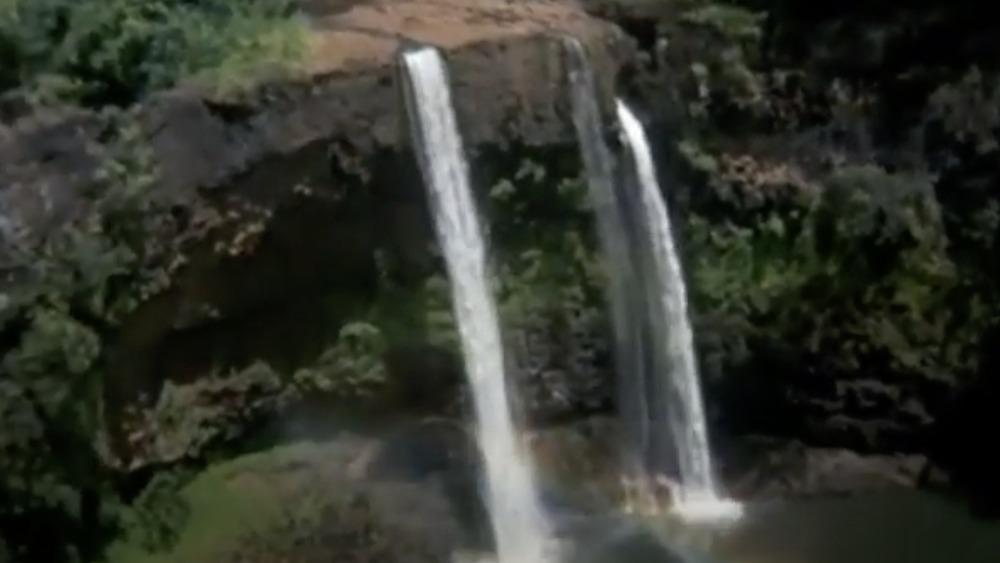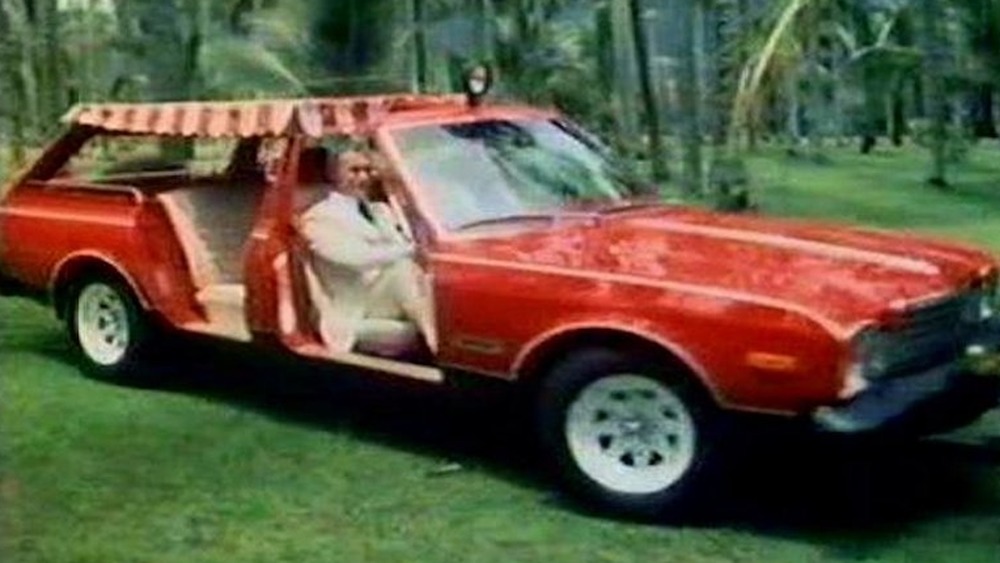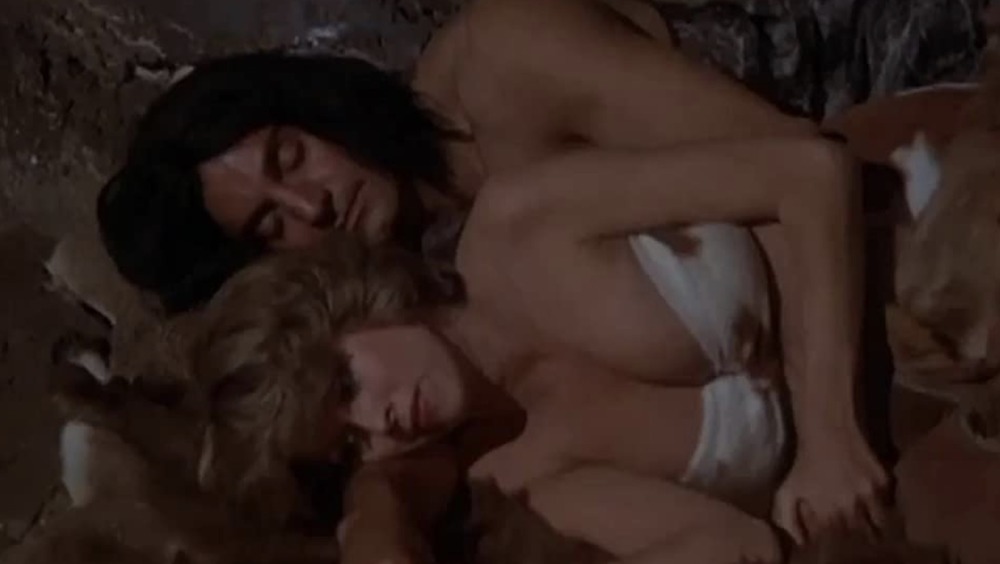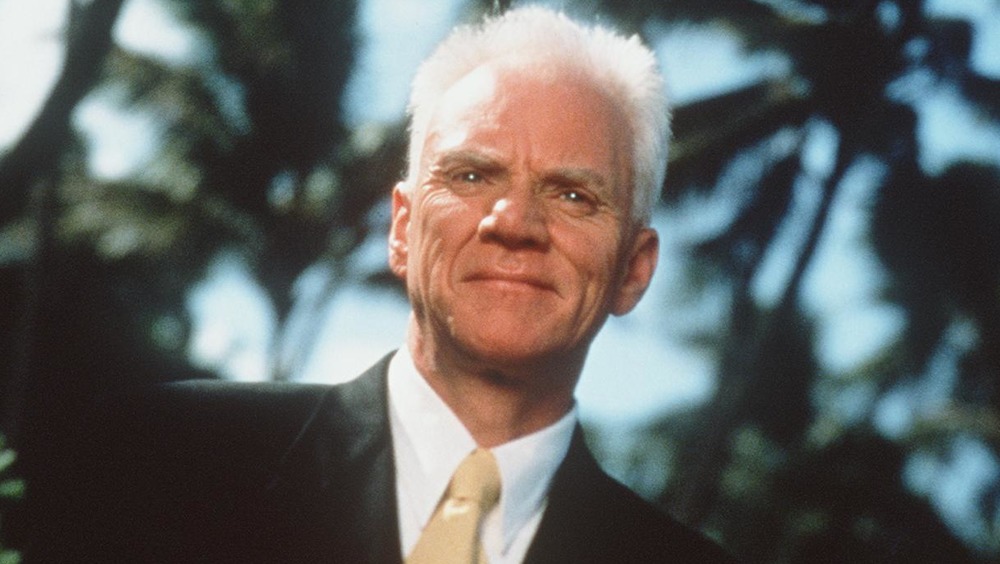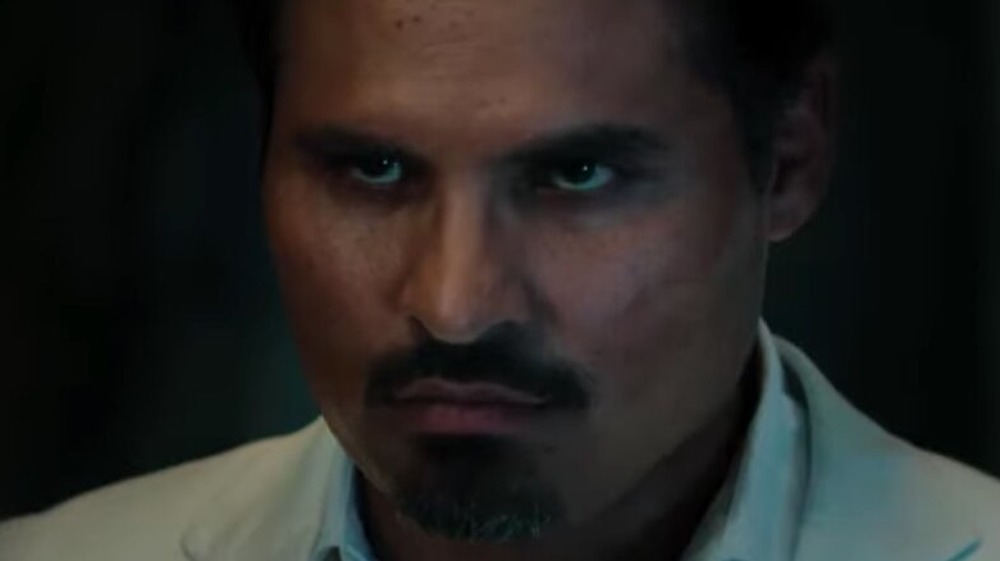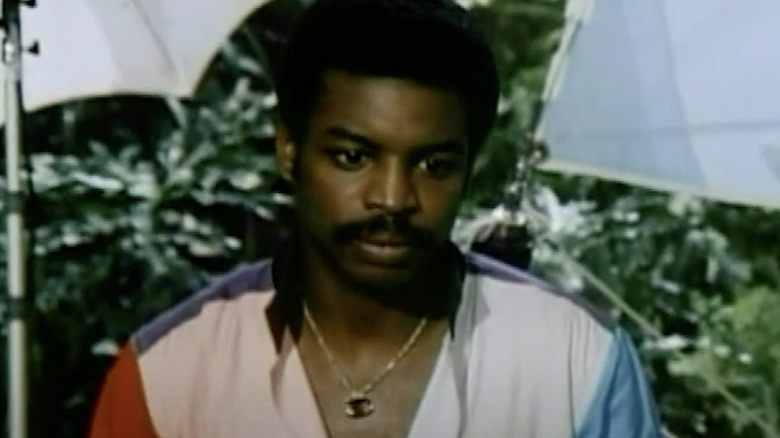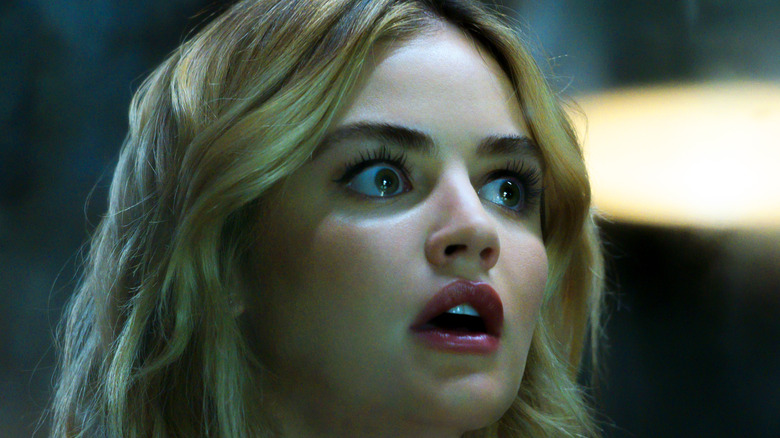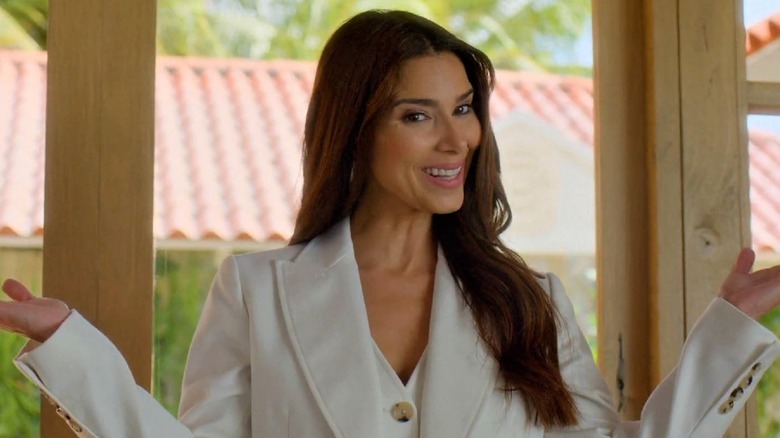15 Fantasy Island Facts That Are The Ultimate Getaway
Decades before the weird and mysterious tropical dystopia of Lost attracted millions of TV viewers to ABC each week, the network regularly delighted audiences with Fantasy Island. A reliable, comforting presence on its Saturday-night lineup for years, the 1976-to-1984 show took place on a beautiful, faraway island where a mysterious, seemingly benevolent gentleman in a white suit known only as Mr. Roarke (Ricardo Montalbán) welcomed guests who'd forked over a small fortune for him and his team of associates (notably his always-present assistant, Tattoo) to conspire to make their wildest dreams come true. But guests of Fantasy Island had to be careful what they wished for — their requests would inevitably take a turn or a twist, and they'd wind up in danger, wanting something else entirely or viewing their life in a whole new way.
As Mr. Roarke might say, smiles everyone: Here's the untold truth of Fantasy Island.
Fantasy Island started as a joke
The premise of Fantasy Island is clear, intriguing, and almost infinitely repeatable: People pay $50,000 for a three-day stay on an island where their wildest fantasy comes true. (And, for the sake of compelling drama, the fantasy goes wrong, and the subject winds up in way over their head.) Such a concise and definable idea is the goal and envy of TV writers everywhere, and one would think that producer Aaron Spelling would have spent a long time coming up with the concept for Fantasy Island. He didn't.
In the late 1970s, ABC executive Brandon Stoddard came to the office of Spelling and his production partner, Leonard Goldberg, wanting to hear pitches for made-for-TV movies. Stoddard didn't like any of Spelling's ideas. "We must have pitched six ideas," Spelling told the Television Academy Foundation, recalling that he was unable to come up with anything "exciting and intriguing" enough for Stoddard. "And I said as a joke, I said, 'Oh, so what do you want, this great island that people can go to and all their sexual fantasies will be realized?'" Now that Stoddard liked. "It was just a joke," Spelling said. "I was just kidding!"
Fantasy Island was a series of movies before it was a show
Made-for-television movies were a huge part of the business of the big three American broadcast networks in the 1970s. In the 1976-77 season, the three channels programmed 11 different movie-of-the-week time slots, with ABC sporting several of them. That's quite a lot of two-hour blocks to fill each week, so ABC hired Aaron Spelling to produce Fantasy Island as a 1976 made-for-TV movie.
It performed well enough that ABC ordered a sequel. When that one hit big with viewers too, ABC, of course, asked Spelling for another. Production was underway on movie number three when ABC executive Fred Silverman called Spelling and told him to scrap the movie, or rather to cut the two-hour project into two separate one-hour projects, because he wanted Fantasy Island to no longer be an occasional film but a regular weekly series instead.
ABC had some interesting casting ideas
Higher-ups at ABC didn't just have a problem with including Hervé Villechaize in the cast of Fantasy Island. Executives had issues with producer Aaron Spelling's choice of actor in the show's only other continuing role, that of mysterious island proprietor Mr. Roarke. Older actor and showbiz veteran Ricardo Montalbán ultimately got the part, but only after Spelling resisted ABC's suggestion to cast a better-known and more acclaimed performer, such as actor and director John Huston, who won an Oscar in 1949 for The Treasure of the Sierra Madre, or Orson Welles, who wrote, directed, and starred in Citizen Kane, widely regarded as the best movie ever made.
Moreover, network executives wanted "an attractive, sexy girl" to serve as Mr. Roarke's assistant, Spelling recalled in A Prime-Time Life. He and producing partner Leonard Goldberg said no to that idea, at least at first, relenting when ingenue Wendy Schaal joined Fantasy Island as Julie, Mr. Roarke's niece, for the 1981–82 season.
ABC wanted a Tattoo removed
Initially, Fantasy Island's regular cast consisted of just two people who appeared in every episode: Ricardo Montalbán as twisted paradise operator Mr. Roarke, and French actor Hervé Villechaize as Mr. Roarke's assistant and constant companion, Tattoo. Already an accomplished artist, Villechaize, who, due to a medical condition, stood less than four feet tall, threw himself into acting in the 1970s and found his breakout role as henchman Nick Nack in the 1974 James Bond movie The Man with the Golden Gun. It was in that film that Fantasy Island producers Aaron Spelling and Leonard Goldberg saw him and thought he'd be great on their show as Tattoo, an assistant for and physical opposite to Ricardo Montalbán's Mr. Roarke. "We both thought he was perfect," Spelling wrote in A Prime-Time Life. "We wanted a different look and the idea of a three-foot-ten sidekick for Roarke was too irresistible to pass up."
Spelling and Goldberg cast Villechaize in the Fantasy Island made-for-TV movies, but when ABC decided to make the show a regular series, it had one big request: Get rid of Tattoo and fire Villechaize. Spelling refused: "We liked the chemistry the way it was, and suggested they do the series without us [meaning himself and Goldberg]." ABC backed off, and Villechaize remained on Fantasy Island.
The plane! The plane!
An airplane was a very important aspect of Fantasy Island. It's how the very special guest stars, or paying guests of Mr. Roarke, arrived at Fantasy Island each week, and it inspired the character Tattoo's catchphrase ("The plane! The plane!"). The actual on-set, day-to-day use of an actual airplane, however, was almost nonexistent. The opening sequence of Fantasy Island is shot from the point of view of an aircraft, taking in the exotic sights of Fantasy Island (rock formations, waterfalls) before it lands a few feet away from Mr. Roarke. Early in the show's production, the crew rented the Grumman Widgeon seaplane from a charter company and got all the aerial footage they'd ever need for the show — and it took just one day. (Apart from its use on Fantasy Island, that plane has another claim to fame in that it was once owned by Richard Bach, the author of the oh-so-'70s feel-good bestseller Jonathan Livingston Seagull, a novel about self-actualization told from the perspective of a bird.)
So if the plane was just used that one time, what did the actors disembark from on any given episode of Fantasy Island? The crew fashioned a not-quite-airworthy fake plane out of primarily plywood.
Hervé Villechaize was fired from Fantasy Island
The breakout star of Fantasy Island was Hervé Villechaize, who portrayed Mr. Roarke's assistant Tattoo. Villechaize became forever associated with "The plane! The plane!" — which he shouted in the show's opening sequences when wealthy guests arrived for their dubious adventure. It's highly likely that as many people watched the show each week for Villechaize as they did for Ricardo Montalbán.
Villechaize had a hefty appetite for physical romance. His The Man with the Golden Gun co-star Roger Moore told The Daily Mail that Villechaize claimed to have coupled with 35 women during the filming of the movie. According to People, Villachaize's on-set dressing room door was adorned with a sign that read "Sex Instructor — First Lesson Free." That was just one source of tension Villechaize brought to the show, according to Fantasy Island producer Aaron Spelling in A Prime-Time Life. The actor's dwarfism led to health problems, such as a serious case of asthma, and he had a hard time handling his fame and at one point began carrying a gun at all times.
But on the record, the reason that Villechaize was dismissed from Fantasy Island was a contract dispute. He was upset that Montalbán made more money than he did, so he sought to at least even things out. In 1983, Villechaize was fired and replaced by Christopher Hewett (Mr. Belvedere) as Mr. Roarke's new assistant, Lawrence. Fantasy Island lasted just one season without Tattoo and was cancelled in 1984.
Is Mr. Roarke the devil, an angel, a ghost, or something else?
Mr. Roarke appears in more than 150 episodes of Fantasy Island, yet viewers learn very little about the character. The action of the show only invites more questions, mostly about the true nature and motivations of Mr. Roarke. It's heavily implied that he isn't quite human, nor a legitimate, honest individual. He seems to delight in getting others to pay a large amount of money to come to his island, where he can thoroughly mess with them, suggesting that Mr. Roarke is a demon or Satan, although he's probably not the latter because Satan visits Fantasy Island in one episode. Mr. Roarke could be a wizard, an immortal being, or simply ancient — he alludes to friendships with long-dead historical figures like Cleopatra and Helen of Troy. He could even be a ghost, as he claims to know the Angel of Death. That one might be close to the truth, or at least as interpreted by Ricardo Montalbán, the actor who portrayed Mr. Roarke.
"The character Mr. Roarke, I had to identify him with something," Montalbán told the Television Academy Foundation, dismissing notions that he was God or the devil. "I decided this man was an angel that still had a little bit of sinner pride in him — too proud," Montalbán added and then suggested that in his mind, Mr. Roarke was "in charge of Purgatory," the in-between place between Heaven and Hell in which some religious people believe.
Fantasy Island isn't any one particular place
As was the plot of most of its episodes, in which the protagonist would get more than they bargained for after the fantasy they paid a lot of money to make happen took a turn for the worse, Fantasy Island is literally too good to be true. The true location of Fantasy Island from Fantasy Island is right there in the name — it's a fantasy, meaning it isn't quite as real as the show did a great job of making viewers believe. The series wasn't shot on location, on some remote island in the Pacific Ocean, nor was it even shot in one place. Most of the show's less exotic scenes were shot on a soundstage, specifically Stage 17 on the Warner Bros. lot in Burbank, California. (Hotel, Life Goes On, and The Drew Carey Show would all later tape in the same space.)
But that memorable opening sequence from Fantasy Island wasn't filmed on some set in the Los Angeles area. Those scenes set the mood for the show and also explain it, depicting a plane arriving at Fantasy Island and Tattoo ringing a bell in a tower to alert Mr. Roarke and his co-workers. The waterfalls in the credits are real, and they're on the Hawaiian island of Kaua'i. The bell tower is adjacent to the famous Santa Anita horse racing track in Southern California.
Mr. Roarke had some sweet wheels
In the early seasons of Fantasy Island, Mr. Roarke tooled around his mysterious tropical paradise in a sport utility vehicle that could handle the various terrain he'd encounter. That was a red 1976 Jeep CJ-7, but in later years, and for the rest of the run of Fantasy Island, Mr. Roarke upgraded to something a bit more flashy, imposing, and suited to his character: a long, red, thoroughly altered 1978 Plymouth Volaré station wagon.
Why Mr. Roarke decided to get a new, larger car wasn't necessarily a sign that the character was making tons of money charging people an arm and a leg for a fantastical island experience but rather reflective of the business contracts of the actor who portrayed Mr. Roarke. A defunct brand since 1999, Plymouth once fell under the corporate umbrella of Chrysler, or DaimlerChrysler, and was primarily known in the 1970s and '80s for its family-friendly fleet of station wagons and minivans. Chrysler's spokesperson in that time period, which overlapped with the run of Fantasy Island was Mr. Roarke himself, actor Ricardo Montalbán. Both actor and character drove a car made by the same company.
There was a minor actor revolt on the set of Fantasy Island
In 1983, Fantasy Island wrapped up its sixth season with "Love Island/The Sisters." Of the two stories in that episode, the first involved a couple of wannabe ladies' men (one of whom was played by Bob Denver of Gilligan's Island) whose fantasy is to inhabit a remote island filled with beautiful women. Every Fantasy Island fantasy has a twist, and the one here is that the island is set in prehistoric times. Robert Firth, a young actor with just a couple of credits at the time, was cast in a small role as "Caveman," and he and a handful of other actors decamped to film the prehistoric island scenes in a section of Bronson Canyon, a wild and rocky section of Los Angeles' Griffith Park that looks so suitably like a land before time that it's a much-used filming location.
Along with all that traffic came signs of human life, namely broken glass and trash on the ground, which was a problem because the actors hired to play cave-people were expected to perform barefoot. "When I realized the potential fate of our collective feet," Firth told Looper, he expressed his apprehension to the people in charge. "That seemed to trigger an avalanche of voices, which led to a stopping of filming," he added. The wardrobe department was contacted, and they provided "some clunky suede prehistoric footwear."
Some Fantasy Island reboots underwhelmed
The original Fantasy Island aired from 1976 to 1984, usually to good ratings and engendering goodwill with the TV-viewing public. That helped to make it a prime candidate for a reboot. In the fall of 1998, ABC brought Fantasy Island back to television, making it a part of its Saturday-night lineup, where the original series had aired to big numbers back in the day.
Starring Malcolm McDowell as Mr. Roarke (instead of Ricardo Montalbán) and a small crew of assistants in lieu of Hervé Villechaize's Tattoo, the new Fantasy Island made it just 13 episodes before ABC cancelled it. It turned out to be an extremely unpopular show, finishing at #119 in the annual Nielsen ratings and ranking as the third-least-watched show among the big four broadcast networks. That's at least better than a 2010s iteration of Fantasy Island, announced in 2015. ABC ordered a script for a reboot in which Mr. Roarke would be a female character, and instead of an island, a San Francisco company would make wishes come true. The project never came to fruition.
Fantasy Island is coming back strong in the 2020s
Never mind those misbegotten attempts to revive Fantasy Island in the late '90s and mid-2010s, because the franchise is experiencing new life for a whole new generation of fans more than 40 years after it debuted on ABC. In 2020, filmmaker Jeff Wadlow leaned into some of the more blatantly terrifying and unsettling aspects of Fantasy Island and co-wrote and directed a big-screen adaptation of the TV series for horror-oriented movie studio Blumhouse Productions. Michael Peña of Ant-Man played Mr. Roarke, reimagined as a dangerous deviant who lures guests to his luxury island, only to terrorize them instead. Despite a lowly seven-percent critical rating on Rotten Tomatoes, Fantasy Island the movie earned a respectable $53 million at the box office.
A few months after the successful theatrical run of Fantasy Island, the Fox network announced that it had ordered a new Fantasy Island TV series. Liz Craft and Sarah Fain, seasoned TV writers who have worked on Angel, The Shield, and The Vampire Diaries, will oversee the show, which will offer a different approach from the original series or the movie. The new Fantasy Island will aim for a positive and inspiring tone, with characters finding a visit to Fantasy Island turning their lives around for the better.
Fantasy Island welcomed a lot of celebrity guest stars
In casting more than 150 episodes over seven years, "Fantasy Island" needed a lot of acting labor, and it served as a great spot for up-and-comers and established TV stars alike to nab some work or keep themselves in the public eye, respectively. Donald O'Connor and Debbie Reynolds of "Singin' in the Rain," and Oscar winner, José Ferrer, all appeared fleetingly in "Fantasy Island," as did nationally popular countdown DJ Casey Kasem, Estelle Getty of "The Golden Girls," and future "Night Court" co-stars, Richard Moll and John Larroquette.
Half the cast of "Happy Days" — Marion Ross, Scott Baio (as the leader of a family band of orphans), Anson Williams, and Don Most — all popped up on the series, as did Larry Wilcox of "CHiPs," Jimmy "J.J." Walker of "Good Times," and Dick York of "Bewitched." Crooners Tom Jones and Englebert Humperdinck also appeared in separate episodes in 1984. Child star and future "Real Housewives of Beverly Hills" cast member Kyle Richards showed up in 1979, just after baseball star George Brett portrayed himself, and just before Patti Davis cameoed — just before her father, Ronald Reagan, was inaugurated as president. Michelle Pfeiffer, Geena Davis, LeVar Burton, and Tori Spelling (daughter of show creator Aaron Spelling) all landed some of their earliest acting gigs in "Fantasy Island."
Fantasy Island came to movie theaters in 2020
Never mind those misbegotten attempts to revive "Fantasy Island" in the late '90s and mid-2010s. The franchise got some new life for a new generation more than 40 years after it debuted on ABC. In 2020, "Truth or Dare" director and "Bates Motel" producer, Jeff Wadlow, found the right angle to reintroduce the campy, comforting TV favorite, and he leaned into some of the more blatantly terrifying and unsettling aspects of "Fantasy Island" and co-wrote and directed a big-screen adaptation of the TV series for horror-oriented movie studio Blumhouse Productions.
Michael Peña of "Ant-Man" played Mr. Roarke, reimagined as a dangerous deviant and all-out horrifying villain, who lures guests to his luxury island, only to terrorize them instead. Other actors featured in the film include Lucy Hale, Maggie Q, and Jimmy O. Yang. Despite a lowly 7% critical rating on Rotten Tomatoes, "Fantasy Island" the movie earned a respectable $53 million at the box office, enough to prove that the title had a substantial fanbase and could be here to stay for another round of twisted wish fulfillment.
Fox returned to Fantasy Island
A few months after the successful 2020 theatrical run of "Fantasy Island," Fox announced that it had ordered and started production on a brand new "Fantasy Island" episodic series. Developed by seasoned speculative TV writers, Elizabeth Craft and Sarah Fain, previously of "Angel" and "The Vampire Writers," the series debuted on Fox in August 2021, and just three months later earned a Season 2 renewal, which premiered as a midseason replacement and aired on Fox in the winter and spring of 2023.
While emerging in the wake of the modest success of the "Fantasy Island" dark cinematic reimagining, the new series is a sequel or continuation of the 1977 to 1984 original show and is thus set in that series' universe. Amidst a mostly constantly changing cast of guest spots, Roselyn Sanchez stars as Elena Roarke, a descendant of the old series' mysterious Mr. Roarke.
The Puerto Rico-filmed reboot even maintains the predecessor show's episode naming conventions and titling installments after its two standalone plot lines about wealthy tourists in search of wish fulfillment. One big change: The new "Fantasy Island" aims for a positive and inspiring tone, with characters finding a visit to Fantasy Island and turning their lives around for the better.
